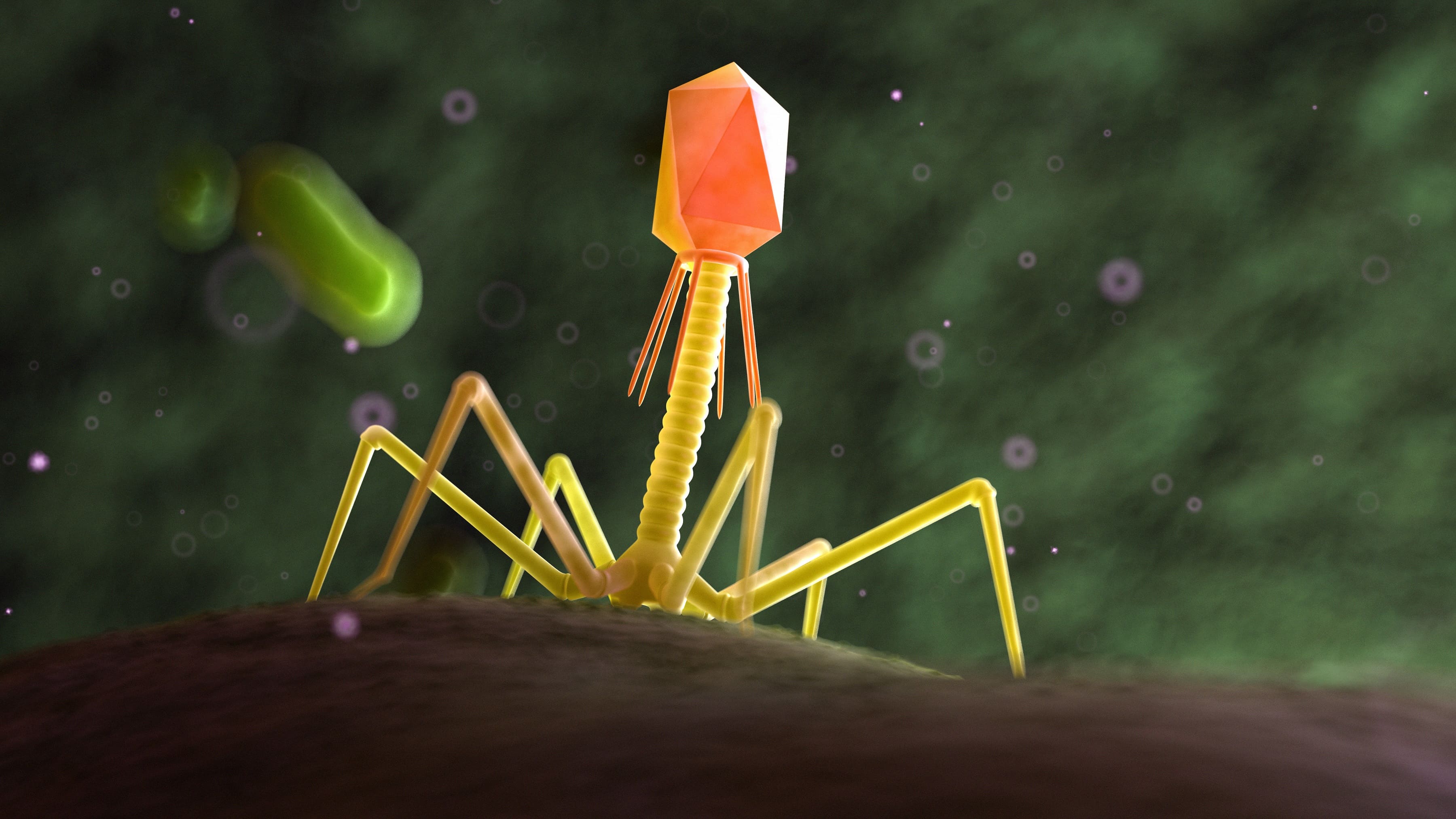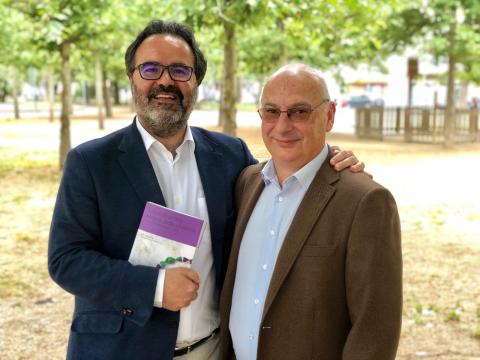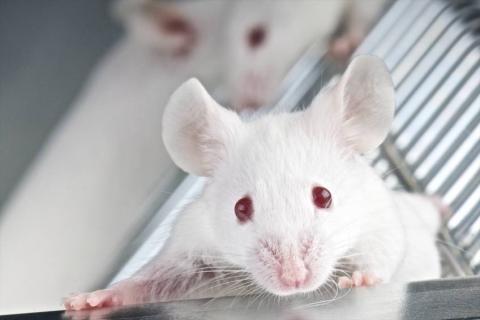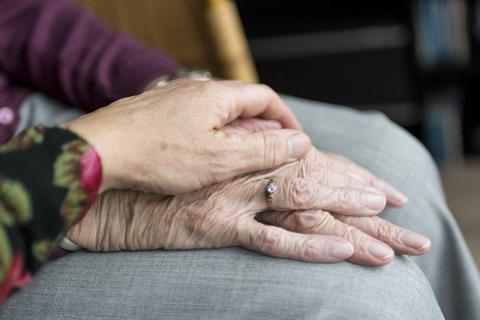Reactions: New particles designed from bacteria-infecting viruses to improve gene therapy
A team of scientists led by the Catholic University of America in Washington has designed new artificial vectors based on viruses to improve gene therapy processes. The main novelty is that they are constructed from viruses that infect bacteria. Among other advantages, this would make it possible to avoid the possible memory of our defences against them and have a greater capacity. According to the authors, who publish their results in the journal Nature Communications, these nanoparticles "have the potential to transform gene therapies and personalised medicine".

Bacteriophage-based virus particles designed to improve gene therapy. / Adobe Stock.
Güell - Virus (EN)
Marc Güell
Coordinator of the Translational Synthetic Biology research group and full professor at Pompeu Fabra University (UPF)
The study is very interesting. Virus engineering for gene therapy has been very successful. Very useful vectors can be made. Examples are lentiviruses or adeno-associated viruses (AAVs) currently used in therapies in patients.
What is very new is that in this study they use a bacterial virus instead of viruses that infect mammals. In addition, it has the property that it can package a lot of DNA (10 times more than lentiviruses and 20 times more than AAVs). This can be very interesting for transferring large genes or complex genetic circuits.
In terms of limitations, the efficiency in in vivo (and ex vivo) situations compared to classical platforms needs to be seen, as well as how biodistribution can be controlled. In addition, when packaging DNA, there is always a risk of insertion (especially if the DNA is so large). This needs to be measured in animal models.
In any case, I think it is a very interesting system. Viruses are very sophisticated molecular machines that now allow us very important levels of engineering.
Chillón - AVV (EN)
Miguel Chillón
Head of the Laboratory of Gene Therapy in Neurodegenerative Diseases of the VHIR-UAB Mixed Unit
It is a very good preliminary study that focuses on the creation of a new gene transfer model based on the bacterial phage T4. Scientifically, the article addresses one of the main issues in the field of gene transfer, namely the amount of material that can be transferred, which in this case is very relevant. In any case, although the article talks about nanoparticles or artificial viral vectors (since for marketing reasons they get better press than the term viral vector), it is still a modified phage (bacterial virus).
The main advantage is the ability to carry up to 170 kilobases of genetic material, but also proteins, such as those needed for gene editing.
As for the limitations, there are some very important ones. Two of them are mentioned in the same article at the end of the discussion: the immune response and the possibility of off-target events associated with gene editing systems. To this I would add the very limited ability to maintain stable expression of the therapeutic gene over time - unless new systems are introduced into the genome that carry these AVVs [artificial viral vectors] - and the specificity of efficiently transducing cell types, unless new versions are generated with new external 'bridging' proteins.
The most relevant and difficult to avoid of all limitations is the immune response it is likely to induce. I would say that this is precisely why the authors have not shown in vivo experiments in animal models, because with all that they have done that last experiment would be easy and would make it very relevant.
Let me explain: T4-AVVs are based on the T4 bacteriophage, i.e. on organisms not seen (let alone in the doses necessary to achieve a therapeutic effect) by humans (nor by mice and the other animal models). Moreover, these T4-AVVs maintain the Hoc protein and incorporate lipid compounds into the capsid, which usually in the presence of immunogenic proteins (as is the case with Hoc), can act as adjuvants and further increase the antigenicity of these immunogens. In other words, they will most likely first induce a strong innate response and, secondly, a humoral immune response that will prevent or make readministration very difficult (key for chronic diseases such as rare genetic diseases, autoimmune diseases, neurodegenerative diseases, etc.). They will most likely also induce a cellular immune response, because while viruses (such as adeno-associated viruses - AAVs) that infect mammals and humans in particular have evolved over millions of years and have mechanisms to avoid, inhibit or reduce host immune responses, T4 bacteriophages have no such capacity.
As for the possibility of their integration into the genome: first, AAVs do integrate, but only those found in nature. Those genetically modified to be therapeutic do not, or if they do, it is in a very inefficient way. In fact, this is a biosafety advantage, as it avoids the risk of insertional mutagenesis. The advantage is that the genome of AAV vectors has a conformation that allows them to remain stable (but not integrated into the genome) throughout the life of the cell. If the cell is a neuron, for example, this means therapeutic expression for the lifetime of the patient, even if it is many years, as in humans. T4-AVVs also do not integrate, which is good for biosafety, but in the particles described in the article I have not seen mechanisms that allow for genome stability as with AAV vectors, although this is something that could be added in future versions.
In summary, this is an interesting system, which addresses one of the important problems of the quantity of genetic material very well, but there are still important points to be resolved, especially the immune response that it can induce, before it can be considered for use in humans.
Gloria - AVVs (EN)
Gloria González Aseguinolaza
Researcher in the Gene Therapy and Regulation of Gene Expression Programme and Director of Innovation and Transfer at Cima University of Navarra
The study contains a tremendous amount of work and is very well done.
They have succeeded in developing a synthetic vector that reproduces the main characteristics of viral vectors, which are characterised by their ability to transfer genetic material into cells.
Until now, the synthetic viruses developed were very inefficient in terms of transferring genetic material to the cell. In this case, in addition, the vector can transfer both genetic material and proteins and can be loaded with large DNA or RNA sequences, which is essential for the treatment of genetic diseases associated with a large gene.
The main limitation is that the study lacks animal data, and this is where the problems will lie. It is a very large and complex vector and it is very likely that its in vivo efficacy will be reduced and it will induce toxic and immune responses, as is the case with large viruses, which will condition its therapeutic efficacy.
Zhu et al.
- Research article
- Peer reviewed
- Experimental study
- In vitro



